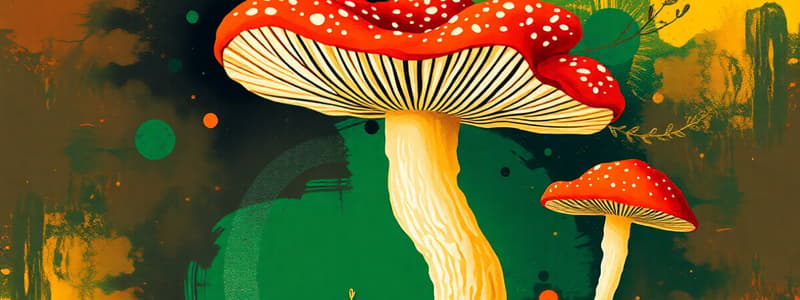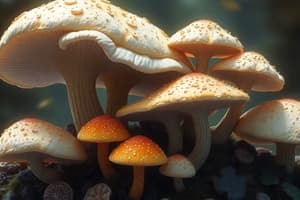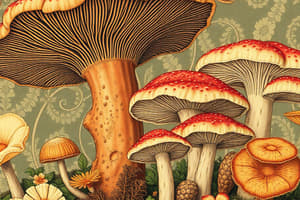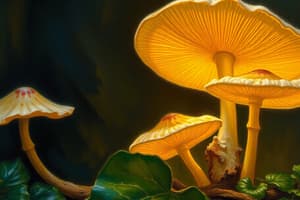Podcast
Questions and Answers
What distinguishes fungi from plants?
What distinguishes fungi from plants?
- Fungi can reproduce sexually.
- Fungi can perform photosynthesis.
- Fungi are eukaryotic organisms. (correct)
- Fungi have chlorophyll.
Which of the following classifications of mycoses is associated with infections deep within the body?
Which of the following classifications of mycoses is associated with infections deep within the body?
- Systemic mycosis (correct)
- Cutaneous mycosis
- Opportunistic mycosis
- Subcutaneous mycosis
Which of the following is true about filamentous (mold-like) fungi?
Which of the following is true about filamentous (mold-like) fungi?
- They do not form spores.
- They reproduce exclusively through budding.
- Their vegetative body is a mass of threads. (correct)
- They exist solely as unicellular organisms.
What type of fungi can switch between filamentous and unicellular forms?
What type of fungi can switch between filamentous and unicellular forms?
What can be a consequence of ingesting certain fungi?
What can be a consequence of ingesting certain fungi?
Which characteristic is unique to fungi compared to bacteria and viruses?
Which characteristic is unique to fungi compared to bacteria and viruses?
How many fungal species are considered to have pathogenic potential for humans?
How many fungal species are considered to have pathogenic potential for humans?
What is a major function of fungal spores?
What is a major function of fungal spores?
What describes the structure of hyphae in fungi?
What describes the structure of hyphae in fungi?
What is characteristic of yeast-like fungi?
What is characteristic of yeast-like fungi?
How do dimorphic fungi change their form?
How do dimorphic fungi change their form?
Which genera of fungi are responsible for cutaneous mycoses?
Which genera of fungi are responsible for cutaneous mycoses?
What causes tinea versicolor?
What causes tinea versicolor?
What is the primary feature of tinea nigra?
What is the primary feature of tinea nigra?
Which fungi are capable of reproducing through budding?
Which fungi are capable of reproducing through budding?
What is a common characteristic of dermatophytes?
What is a common characteristic of dermatophytes?
What is the primary causative organism of sporotrichosis?
What is the primary causative organism of sporotrichosis?
What symptom primarily distinguishes tinea pedis from other fungal infections?
What symptom primarily distinguishes tinea pedis from other fungal infections?
Which of the following describes the lesions of tinea corporis?
Which of the following describes the lesions of tinea corporis?
What is typically required for the treatment of tinea unguium?
What is typically required for the treatment of tinea unguium?
How are subcutaneous mycoses primarily acquired?
How are subcutaneous mycoses primarily acquired?
In tinea capitis, which of the following signs can occur?
In tinea capitis, which of the following signs can occur?
What distinguishes tinea cruris from tinea corporis?
What distinguishes tinea cruris from tinea corporis?
Which fungal infection often leads to granulomatous ulceration at the puncture site?
Which fungal infection often leads to granulomatous ulceration at the puncture site?
Which group of pathogens primarily infects healthy individuals?
Which group of pathogens primarily infects healthy individuals?
What type of mycoses primarily affect debilitated or immunocompromised individuals?
What type of mycoses primarily affect debilitated or immunocompromised individuals?
What is the most common fungal nosocomial pathogen identified in hospital settings?
What is the most common fungal nosocomial pathogen identified in hospital settings?
Which condition is associated with raised, white plaques on the oral mucosa?
Which condition is associated with raised, white plaques on the oral mucosa?
Which of the following systemic mycotic infections is commonly seen in an immunocompetent host?
Which of the following systemic mycotic infections is commonly seen in an immunocompetent host?
Which specific change in the population has contributed to the increase in opportunistic fungal pathogens?
Which specific change in the population has contributed to the increase in opportunistic fungal pathogens?
Which of the following conditions presents as itching and burning pain of the vulva and vagina?
Which of the following conditions presents as itching and burning pain of the vulva and vagina?
What characteristic is true about Candida albicans?
What characteristic is true about Candida albicans?
Flashcards
What distinguishes fungi from other organisms like plants?
What distinguishes fungi from other organisms like plants?
Fungi are organisms without chlorophyll or chloroplasts, and are classified as their own kingdom, Mycota. They are classified by their ability to derive nourishment from dead organic matter (saprophytic) or by being parasitic.
Out of all the fungal species, how many are potentially harmful to humans?
Out of all the fungal species, how many are potentially harmful to humans?
Only about 100 out of the approximately 200,000 fungal species are known to be potentially harmful to humans. This highlights the importance of understanding specific fungal species.
How are fungal infections categorized?
How are fungal infections categorized?
Fungal infections are classified by where they occur on or in the body. Cutaneous infections are confined to the skin, subcutaneous infections penetrate deeper, and systemic infections affect internal organs or spread throughout the body.
What are the two types of systemic mycoses?
What are the two types of systemic mycoses?
Signup and view all the flashcards
How can fungi cause harm beyond infection?
How can fungi cause harm beyond infection?
Signup and view all the flashcards
What is the role of fungal spores?
What is the role of fungal spores?
Signup and view all the flashcards
How does fungi's cellular structure differ from other infectious organisms?
How does fungi's cellular structure differ from other infectious organisms?
Signup and view all the flashcards
What are the two primary forms of fungal growth?
What are the two primary forms of fungal growth?
Signup and view all the flashcards
Filamentous fungi
Filamentous fungi
Signup and view all the flashcards
Septate vs. Nonseptate Hyphae
Septate vs. Nonseptate Hyphae
Signup and view all the flashcards
Yeast-like fungi
Yeast-like fungi
Signup and view all the flashcards
Dimorphic Fungi
Dimorphic Fungi
Signup and view all the flashcards
Cutaneous Mycoses (Dermatophytoses)
Cutaneous Mycoses (Dermatophytoses)
Signup and view all the flashcards
Dermatophyte Genera
Dermatophyte Genera
Signup and view all the flashcards
Tinea Versicolor
Tinea Versicolor
Signup and view all the flashcards
Tinea Nigra
Tinea Nigra
Signup and view all the flashcards
True pathogenic mycoses
True pathogenic mycoses
Signup and view all the flashcards
Opportunistic mycoses
Opportunistic mycoses
Signup and view all the flashcards
Nosocomial infections
Nosocomial infections
Signup and view all the flashcards
Candidiasis
Candidiasis
Signup and view all the flashcards
Systemic Candidiasis
Systemic Candidiasis
Signup and view all the flashcards
Cryptococcosis
Cryptococcosis
Signup and view all the flashcards
Mycetoma
Mycetoma
Signup and view all the flashcards
Chromomycosis
Chromomycosis
Signup and view all the flashcards
Tinea pedis
Tinea pedis
Signup and view all the flashcards
Tinea corporis (Ringworm)
Tinea corporis (Ringworm)
Signup and view all the flashcards
Tinea capitis (Scalp ringworm)
Tinea capitis (Scalp ringworm)
Signup and view all the flashcards
Tinea cruris (Jock itch)
Tinea cruris (Jock itch)
Signup and view all the flashcards
Tinea unguium (Onychomycosis)
Tinea unguium (Onychomycosis)
Signup and view all the flashcards
Subcutaneous mycoses
Subcutaneous mycoses
Signup and view all the flashcards
Sporotrichosis
Sporotrichosis
Signup and view all the flashcards
Study Notes
Medical Important Fungi
- Fungi are diverse, saprophytic (feeding on dead organic matter) and parasitic eukaryotic organisms.
- Previously classified with plants, they are now in their own kingdom, Mycota.
- They can be aerobic or facultatively anaerobic.
- Chemoheterotrophic, deriving nourishment from organic matter.
- About 200,000 fungal species exist, but only approximately 100 are clinically significant in terms of human infections.
Structure and Classification of Fungi
- Fungi can be unicellular or multicellular.
- Some fungi, like mushrooms, can be harmful if ingested.
- Some fungi produce toxins that can cause a variety of illnesses.
- Some molds and yeasts can be seen with the naked eye.
- Some produce toxins that can cause cancer, and/or other illnesses.
Overview
- Fungi have cell walls made of chitin.
- Unlike plants, they do not contain chlorophyll.
- Some fungi can grow in environments without oxygen.
Mycoses
- Human fungal diseases (mycoses) are classified based on the body location of infection.
- Cutaneous mycoses—limited to epidermis (outer skin layer).
- Subcutaneous mycoses—penetrated down through the skin.
- Systemic mycoses—spread throughout the body.
- Mycoses can be true pathogens or opportunistic pathogens.
Fungal Growth in the Human Body
- Fungi primarily infect skin, hair and nails (superficial mycoses).
- Fungi can also infect deeper layers of skin (subcutaneous mycoses).
- Or spread through the body (systemic mycoses).
Other Medical Importance
- Fungi produce and secrete diverse metabolic products; some are highly toxic when ingested.
- Poisoning from ingestion can be fatal in humans and animals.
- Lastly, fungal spores are critical for dispersal and transmission.
Pathogenic Fungi
- True Pathogens: Cause disease in healthy individuals.
- Opportunistic Pathogens: Typically cause disease only in those with weakened immune systems.
Major Fungal Groups
- Fungi are distinguished from bacteria and viruses because they are eukaryotic.
- Fungi lack chlorophyll and chloroplasts.
- Distinguishing features like structural characteristics, habitats and growth methods are applied to classify different fungal groups.
Comparison of Fungi and Bacteria
- Fungi are usually larger and eukaryotic compared to bacteria.
- Bacteria are typically prokaryotic and much smaller.
Fungi Compared to Other Kingdoms
- Fungi have a chemoheterotrophic nutritional type (obtaining energy and carbon from organic sources).
- Algae, protists, and helminths have different nutritional types.
- Their presence within body systems may cause various illnesses in individuals and/or animals.
Modes of Fungal Growth
- Most fungi exist as either filamentous molds or unicellular yeasts.
- Some fungi have dimorphic capabilities.
- Filamentous fungi are composed of threads called hyphae. Hyphae may be septate or aseptate.
- Budding yeasts reproduce through asexual budding.
- These types of fungi may cause illness in individuals.
Filamentous (Mold-like) Fungi
- The vegetative body or thallus of a mold is a mass of branching threads called mycelium.
- The threads are called hyphae, which are tubular cells that may be septate or nonseptate.
Yeast-like Fungi
- Yeast-like fungi exist as single, unconnected spheroid cells.
- 10 times larger than bacteria.
- Reproduce either by budding or fission.
Dimorphic Fungi
- Some fungal species can switch between yeast and mold forms.
- The form depends on factors like temperature and carbon dioxide levels.
- Environmental factors affect morphology.
Fungal Life Cycle
- Fungi reproduce asexually and/or sexually.
- The reproduction methods depend on the fungus species.
Cutaneous Mycoses
- These are infections of the skin, hair and nails caused by dermatophytes (group of fungi).
- Dermatophytes fall into three genera.
- Each genus includes many species.
Subcutaneous Mycoses
- Fungi infect the dermis, subcutaneous tissue and bones.
- Causative organisms live in soil and decaying vegetation.
- Fungi that commonly cause illness.
General Properties of Subcutaneous Infections
- Subcutaneous infections are generally acquired through trauma such as lacerations or puncture wounds.
Sporotrichosis
- A subcutaneous mycosis.
- Characterized by a granuloma at the infection site.
- Secondary lesions along lymphatic channels.
- The causal agent, Sporothrix schenckii, is a dimorphic fungus. (Sporothrix schenckii exists in both a yeast and mycelial form).
Chromomycosis
- Caused by various fungi.
- Characterized by skin lesions.
Mycetoma
- Characterized by subcutaneous lesions that can lead to bone infection.
Systemic Mycoses
- Infect normal healthy individuals.
- May infect immunocompromised individuals.
- Several types of systemic mycoses exist; they may cause death.
Opportunistic Mycoses
- Primarily affect individuals with immune deficiencies.
- The use of immunosuppressants for organ and cancer treatment increases the prevalence of fungal infections.
Nosocomial Infections
- Fungal infections acquired during treatment in hospitals, frequently in intensive care units (ICUs).
- Candida species are a common cause.
Candidiasis
- Caused by Candida albicans and other Candida species.
- Commonly found as normal body flora on skin, mouth, vagina and intestines.
- Most fungi are opportunistic pathogens.
- Can form a true mycelium.
Mucous Membranes
- Oral thrush (oral candidiasis)—characterized by white plaques in the mouth and throat.
- Vaginal candidiasis—characterized by itching and burning, with possible white vaginal discharge.
- Other Candida infections involving the esophagus are also possible.
Systemic Candidiasis
- A potentially life-threatening infection.
- Occurs in immunocompromised patients.
Cryptococcosis
- Caused by Cryptococcus neoformans yeast.
- Often found in soil containing bird droppings(especially pigeons' droppings).
- Can cause meningitis.
Aspergillosis
- Caused by several species of Aspergillus, usually A. fumigatus.
- Can infect lungs.
- More commonly found in immunocompromised individuals.
Pneumocystis jiroveci
- Caused by P. jiroveci (formerly P. carinii) a yeast-like fungus.
- Causes pneumonia.
Studying That Suits You
Use AI to generate personalized quizzes and flashcards to suit your learning preferences.




